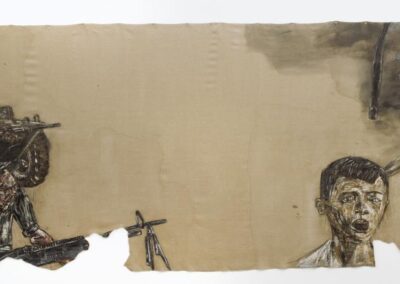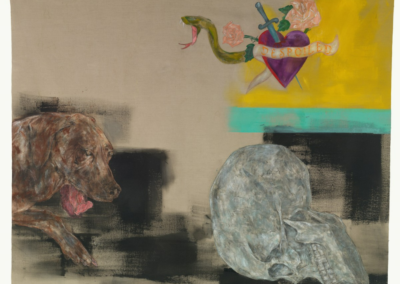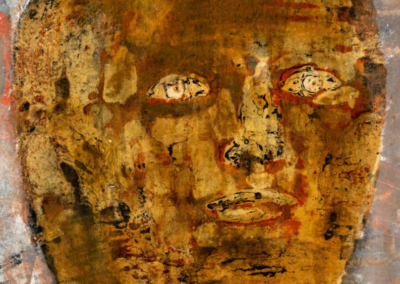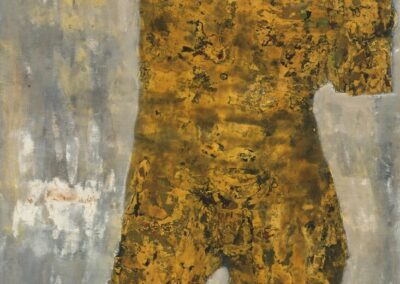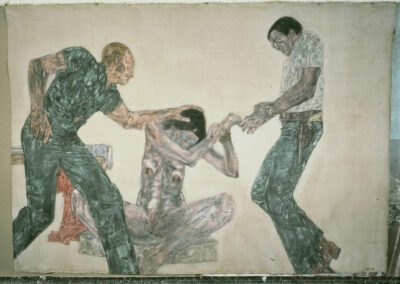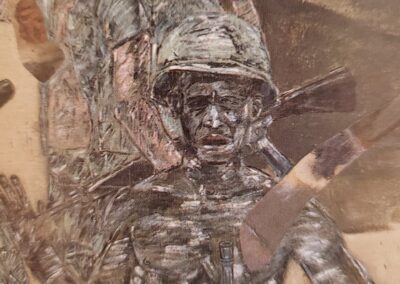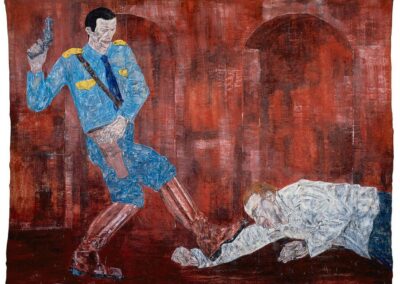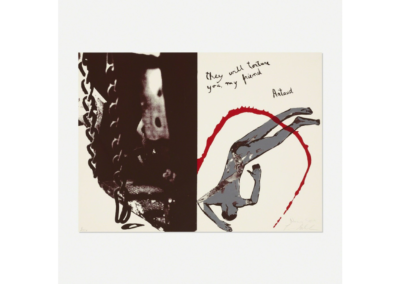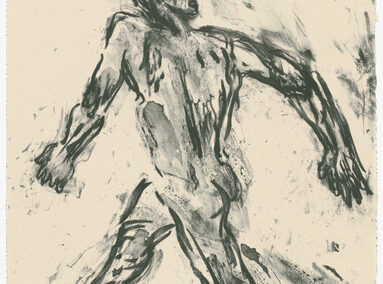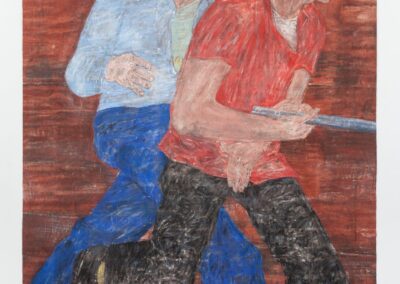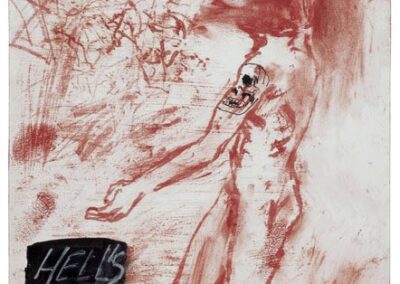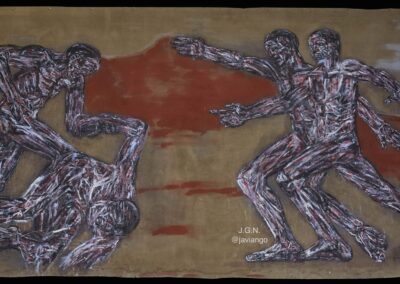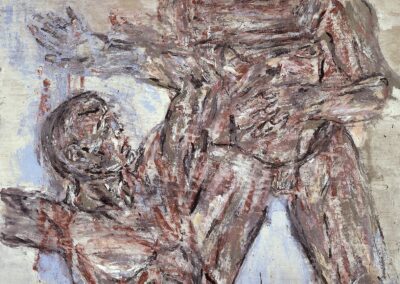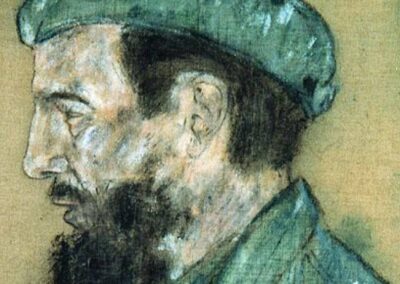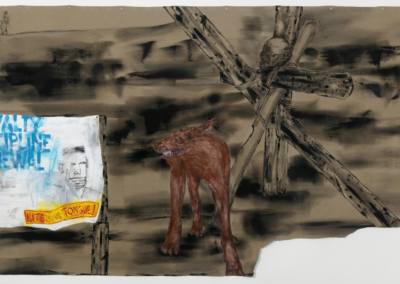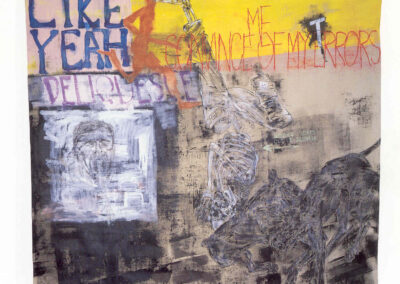The next Artist You Need To Know is Leon Golub (1922 – 2004).
Golub was an American painter whose work has been described as neo expressionist, and his works have both a dynamism and starkness as they responded to larger social and history issues. Best known for his large scale works with figures often larger than life, Golub’s scenes are both unsettling and entrancing, often grotesque but gripping nonetheless. In describing Leon Golub’s work, critic Jerry Saltz has spoken of Golub’s art as “blowtorch realism.”
In the late 1980s, Golub offered the following about art : “Artists manage extraordinary balancing acts not merely of survival or brinkmanship but of analysis and raw nerve.”
From The Art Story : Golub “carried within an unfailing love of people despite his ongoing exploration of the most monstrous scenes of humanity. Still strikingly relevant today, his paintings explore themes of struggle, conflict, and perverse power relations especially in times of war. He was inspired by ancient and contemporary source material alike; a gleaner of information of news stories from popular media, but also a learned classical art historian. Intrigued by the individual, he made portraits of significant personalities, yet simultaneously Golub rejected self-involvement to instead inspire engagement, collaboration, and to situate his art as a call for active resistance against all injustice.”
Born in Chicago, Golub earned a BA at the University of Chicago (1942) and later both a BFA (1949) and MFA (1950) from the Art Institute of Chicago. He had served in the U.S. Army between his BA and later degrees, and like many artists of his generation attended university on the G.I. Bill. During this time he met Nancy Spero, a significant artist in her own right, and they would often collaborate over their nearly fifty years of marriage.
Early in his career, he was associated with the Chicago art group known as The Monster Roster as the artists in this group shared an interest in socially conscious work and a gritty, confrontational style that mixed contemporary issues with expressionistic renderings. This was a formative moment in Golub’s career : The Monster Roster collective “believed that an observable connection to the external world and to actual events was essential if art was to have any relevance to the viewer or society. This is a view that informed Golub’s work throughout his career.” (from here)
From 1959 to 1964, Golub and Spero lived in Paris, as both felt that the European theatre would be more receptive to the political nature of their work. When they returned to the United States in 1964 and in response to the intensity of the Vietnam War in popular and cultural spheres at that time, Golub produced two major bodies of work titled Vietnam and Napalm. Kelly Baum – curator of Leon Golub: Raw Nerve – asserts that “Golub’s paintings were a response to the brutality he saw in the media. As an activist, his paintings represent the violence he was opposed to.”
Golub often depicted scenes with an unflinching and unsettling brutality of concept but excellence of execution. He would turn his eye from Vietnam to more “global conflicts” and the other “smaller colonial, proxy and dirty wars that continued around the globe through the 1980s…. dispassionate recording and witness-bearing.” (from here)
Many historians and arts writers have spoken of Golub as a history painter, within the tradition of Francisco Goya’s The Disasters of War / Los desastres de la guerra (1810 to 1820) or Jacques Callot’s The Mysteries and Misfortunes of War / Les Grandes Misères de la guerre (1633).
“In tune with his roots, Golub cleverly incorporates his work into the trajectory of European figurative painting. His pictures behold the drama of Expressionism but with unflinching integrity move away from inward angst to explore the same practical, political, and outward reaching worldly goals of the New Objectivity artists (including Max Beckmann, George Grosz, and Otto Dix).
During the late 1940s, 50s, and 60s Golub’s work was often spurned and not given due attention because of the American preference for abstraction, and later, for Minimalism. Due to Golub’s perseverance, and to that of other individual artists, in the late 1970s, Neo-Expressionism emerged and the revealing power of figuration was once again revived.
Golub makes paintings that also have sculptural, drawing, and tapestry-like qualities and thus challenges the viewer’s perception of what makes a painting. Thick paint is scraped and moulded on application and un-stretched and un-framed canvas make the works appear as though works on paper or fabric hangings. As such, by using apparently endless backgrounds, Golub successfully translates ideas and intentions that cannot be easily contained or concluded.” (from here)
He would continue a political focus in his work over his career. Golub produced a series of portraits of several political leaders throughout the world with (to be polite) contested histories and roles, as well as series titled Mercenaries, Interrogation, Riot, and Horsing Around.
Golub’s work is to be found in a multitude of private and public collections. Notable institutions that have his work include the Art Institute of Chicago, Baltimore Museum of Art, Bibliothèque nationale de France, Brooklyn Museum (New York), Carnegie Museum of Art (Pittsburgh, Pennsylvania), Cincinnati Art Museum, Galleria degli Uffizi (Florence), Hiroshima City Museum of Contemporary Art (Hiroshima, Japan), Israel Museum (Jerusalem), Jewish Museum (New York), Los Angeles County Museum of Art, Metropolitan Museum of Art (New York), Musei Civici di Udine (Friuli, Italy), Museum of Contemporary Art (Chicago), MOMA (Museum of Modern Art, New York), National Gallery of Art (Washington, D.C.), Vietnam National Museum of Fine Arts (Hanoi), the Whitney Museum of American Art (New York) and many, many others.
Golub exhibited widely during his career. But several significant exhibitions include a 2015 career retrospective at the Serpentine Gallery in London which was re imagined as a massive exhibition (comprising three floors) at the Manhattan Hauser & Wirth later that same year. Seven years later, the Hall Art Foundation (Reading, Vermont, USA) mounted a survey exhibition that had nearly 70 works by Golub. These spanned his career from 1947 to 2003, and this would travel to the Kunstmuseum Schloss Derneburg in Germany.
From The Broad : “For Golub abuse of power is both an ancient and a contemporary condition, always present in the world, and the ability of such power to corrupt those who hold it chips away at humanity. Both the victims and the orchestrators of torture and suffering reside outside of ethical boundaries, in a place where social contracts of dignity lie in ruin. Golub portrays a horrible world of degradation, where humans have more in common with objects than subjects, where the right to freedom is flagrantly abandoned.”
Leon Golub passed away at the age of 82, in 2004. More about Leon Golub’s life and work can be enjoyed here.


